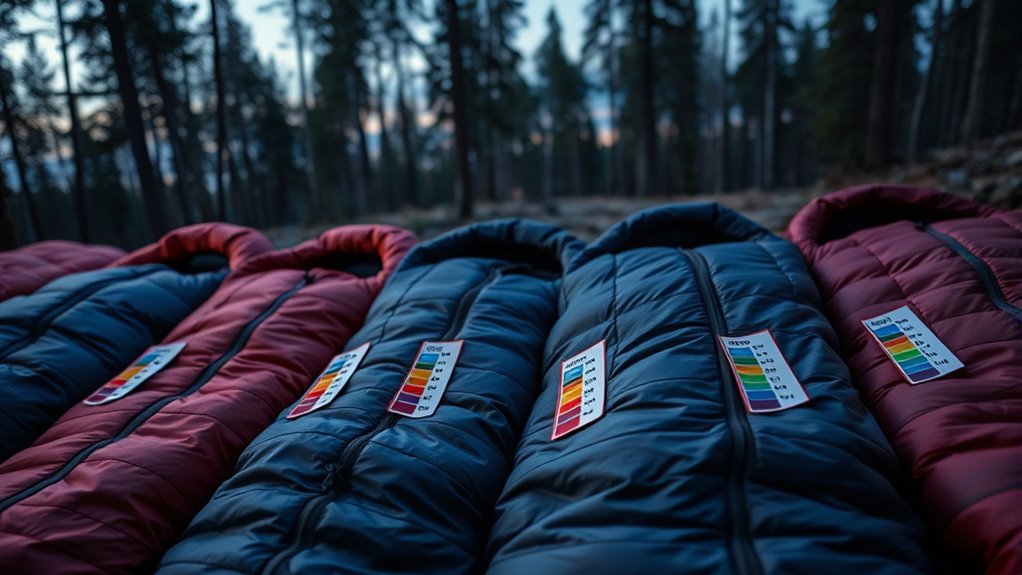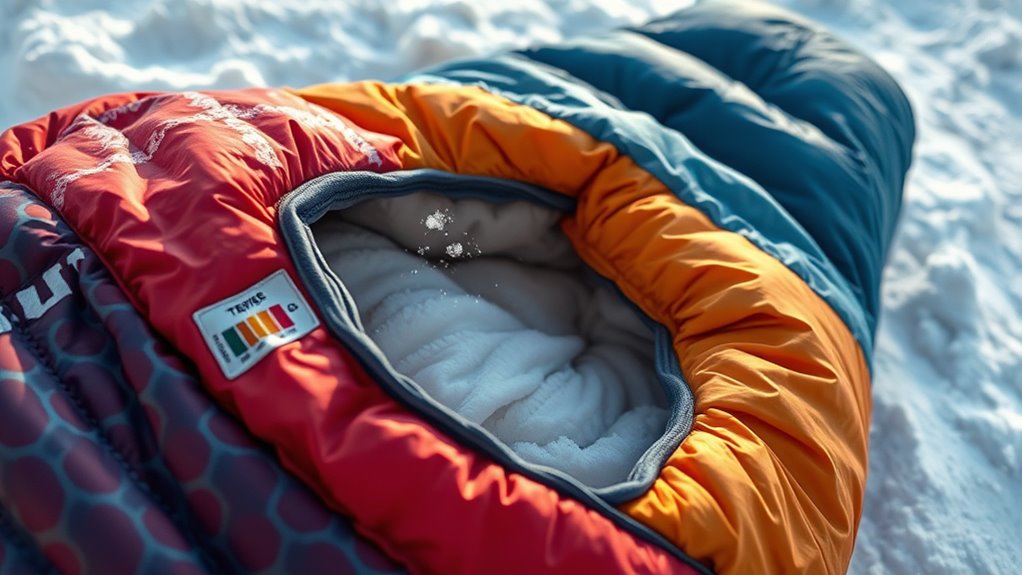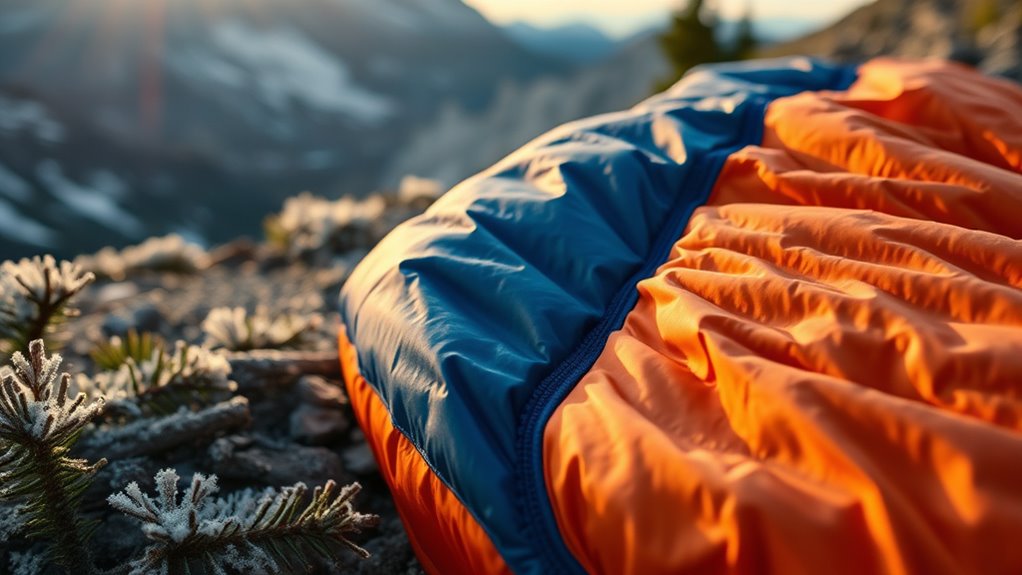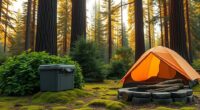Sleeping bag temperature ratings tell you how warm a bag will keep you in different conditions. Comfort ratings show where you’ll sleep cozy, while limit ratings indicate the coldest you can survive comfortably. Extreme ratings are for short-term safety in very cold weather. Choosing the right one depends on your outdoor plans and personal tolerance. Understanding these ratings helps you stay safe and warm, and you’ll discover more tips to pick the best sleeping bag for your trip.
Key Takeaways
- Temperature ratings indicate a sleeping bag’s ability to keep users warm in specific conditions, including comfort, limit, and extreme levels.
- Comfort ratings show where sleep remains cozy; limit ratings specify the lowest survivable temperature; extreme ratings indicate short-term survival thresholds.
- Different ratings help you choose a bag suited for three-season, winter, or specific outdoor conditions based on expected weather.
- Ratings are standardized but may vary between manufacturers; personal factors like body heat and clothing also influence comfort.
- Selecting a bag with an appropriate temperature rating ensures safety, warmth, and restful sleep during outdoor adventures.
Understanding Temperature Ratings and Standards

Understanding temperature ratings and standards is essential when choosing a sleeping bag, as these ratings indicate how cold a bag can keep you comfortable. Your sleeping bag insulation plays a key role in maintaining effective temperature regulation, trapping heat to keep you warm in chilly conditions. Different ratings, like comfort and limit, help you assess whether the bag suits your planned environment. Comfort ratings tell you the temperature at which the bag will keep you cozy while sleeping, while limit ratings indicate the lowest temperature where you might still stay alive but not comfortably. Knowing these standards helps you select the right insulation and temperature regulation features, ensuring you stay warm without overheating, and making your outdoor adventures safer and more enjoyable. Additionally, understanding sleeping bag standards can help you compare products effectively and choose the best option for your needs.
Different Types of Sleeping Bag Temperature Ratings

When choosing a sleeping bag, you’ll notice different temperature ratings like standard, comfort, and limit. These ratings help you understand how warm you’ll stay in various conditions. Knowing what each rating signifies ensures you pick the right bag for your outdoor adventures. Embracing a growth mindset can also help you become more comfortable with trying different gear and understanding your personal comfort zone.
Standard Temperature Ratings
Standard temperature ratings provide a clear way to compare sleeping bags based on the conditions they’re designed to handle. These ratings often include categories like “Extreme” and “Limit,” which help you understand how a bag performs in specific scenarios. They serve as a foundation for sleep system integration, allowing you to choose bags that match your needs across seasonal variations. For example, a three-season bag is suitable for spring, summer, and fall, while a winter bag is designed for colder conditions. Keep in mind that these ratings are standardized, but individual comfort can vary. Understanding the different types of standard temperature ratings helps you pick the right sleeping bag for your trip, ensuring safety and comfort regardless of the weather.
Comfort vs. Limit
Different temperature ratings on sleeping bags serve specific purposes, with the most common being the comfort and limit ratings. The comfort rating indicates the temperature where you’ll feel comfortably warm while sleeping, thanks to proper sleeping bag insulation. The limit rating shows the lowest temperature where you can expect to stay alive without serious cold stress, though you might find it uncomfortable. These ratings help you account for temperature fluctuation, as conditions can vary unexpectedly. Your body’s response to cold, combined with insulation quality, influences how well a sleeping bag performs at each rating. Understanding these differences allows you to choose a bag that matches your tolerance and planned conditions, ensuring a safe and restful night despite changing temperatures.
Interpreting Comfort, Limit, and Extreme Ratings

Understanding the differences between comfort, limit, and extreme temperature ratings is essential for choosing the right sleeping bag. Comfort ratings indicate the temperature where you can sleep comfortably without feeling cold, based on proper sleeping bag insulation. Limit ratings show the lowest temperature where an average person can sleep without waking due to cold, reflecting a more conservative estimate. Extreme ratings represent the temperature at which you might survive for a short period but risk hypothermia if exposed too long. Keep in mind, these ratings are based on standardized temperature calibration, which can vary between manufacturers. Your personal comfort may differ depending on factors like body metabolism, clothing, and weather conditions. Proper interpretation guarantees you select a sleeping bag suited to your outdoor environment and personal needs. Additionally, understanding battery technologies can help you plan for reliable power sources during outdoor adventures or emergencies.
How to Choose the Right Temperature Rating for Your Trip

Choosing the right temperature rating for your trip starts with evaluating the expected weather conditions and your planned activities. Consider how you’ll handle nighttime thermoregulation—if you tend to get cold easily or stay warm, select a sleeping bag with suitable insulation. A bag rated for slightly lower temperatures than forecasted provides extra comfort and safety. Think about your sleeping style—if you move around a lot or sleep lightly, opt for higher insulation ratings. If you’re backpacking in unpredictable weather, go for a versatile, well-insulated bag. Remember, sleeping bag insulation impacts how well you retain heat, so choose a rating that aligns with your comfort needs. Proper selection ensures you stay warm without overheating, giving you restful sleep even in cooler conditions. Additionally, incorporating rustic decor elements can create a cozy atmosphere that enhances your overall camping experience.
Factors That Affect Sleep Temperature in the Outdoors

Several outdoor factors can influence how warm or cool you feel during sleep, regardless of your sleeping bag’s rating. Climate variability plays a significant role; sudden temperature drops or fluctuating weather can make you feel colder than expected. Your sleep environment also matters—wind exposure can strip away body heat, while humidity can affect insulation efficiency. Elevation impacts temperature, with higher altitudes generally being colder. Ground conditions, such as dampness or snow, can draw heat away from your body. Additionally, your body’s own activity level and clothing choices influence comfort. Being aware of these factors helps you better understand why your actual sleep temperature might differ from the rating and encourages you to adapt your gear and setup accordingly for a more comfortable night outdoors. Recognizing the importance of practical mindfulness in adjusting to changing conditions can help you stay more comfortable and focused during your outdoor adventures.
Tips for Staying Warm and Safe With Your Sleeping Bag

To stay warm and safe with your sleeping bag, it’s essential to prepare properly before heading outdoors. Start by choosing the right pillow selection; a supportive pillow helps maintain proper insulation and prevents heat loss from your head. Additionally, consider your tent insulation—adding a ground pad or using a tent with good insulating properties can block cold drafts and retain heat. Keep your sleeping bag dry and avoid overpacking it, as moisture reduces its insulating ability. Dress appropriately in thermal layers and avoid overdressing inside the bag to prevent sweating, which can cool you down once you stop moving. Always check weather conditions and adjust your setup accordingly to guarantee you stay warm and safe throughout the night. Being aware of sleeping bag temperature ratings can help you select the appropriate bag for different conditions.
Frequently Asked Questions
How Do Sleeping Bag Ratings Vary Across Brands?
You’ll find that sleeping bag ratings vary across brands due to differences in how they test and rate their products, leading to rating variability. Brand consistency is often lacking, so a “comfortable” rating from one brand might not match another’s standards. To stay safe, always check specific brand guidelines and user reviews rather than relying solely on the ratings, as they can differ markedly between manufacturers.
Can I Use a Summer Sleeping Bag in Winter?
You shouldn’t use a summer sleeping bag in winter because it’s designed for warmer conditions. Instead, look for seasonal sleeping bags rated for cold weather, or use layering strategies with a winter bag for added warmth. Combining a summer bag with extra insulation might work temporarily, but it’s not reliable. Always choose a sleeping bag rated for the lowest temperatures you expect to face to stay safe and comfortable.
What Are the Signs of a Sleeping Bag’s Insulation Deterioration?
You’ll notice insulation breakdown when your sleeping bag no longer keeps you warm, feeling less cushioned or flat over time. Wear and tear, like ripped fabric or compressed insulation, also signal deterioration. If your bag feels less effective, smells musty, or has visible damage, it’s time to inspect it closely. Regular use and washing can accelerate insulation breakdown, so check for these signs to make sure you stay warm on your adventures.
How Does Humidity Affect Sleeping Bag Warmth?
Humidity impact profoundly affects your sleeping bag’s warmth because moisture retention can make insulation less effective. When humidity is high, your sleeping bag absorbs moisture, reducing its insulation properties and increasing heat loss. This means you might wake up feeling colder than expected. To stay warm, keep your bag dry, use a waterproof cover if needed, and try to minimize exposure to humid conditions, ensuring your insulation works efficiently.
Are There Recommended Sleeping Bag Ratings for Car Camping?
For car camping, you should choose seasonal sleeping bags with appropriate temperature ratings based on the expected weather. Look for bags with temperature ratings that match the lowest temperatures you’ll encounter, often around 20°F to 32°F for spring or fall. Stick to bags adhering to recognized temperature rating standards, so you know their warmth levels are dependable. This ensures you stay comfortable and safe during your camping trips.
Conclusion
Choosing the right sleeping bag temperature rating is like finding a cozy blanket in a cold winter storm—you want warmth without sacrificing comfort. By understanding standards, ratings, and the factors that influence your sleep, you can pick the perfect bag for your adventure. Remember, your outdoor sleep setup is your sanctuary amid nature’s unpredictability. Stay informed, stay warm, and let your nights under the stars be a peaceful, restorative escape from the world.









